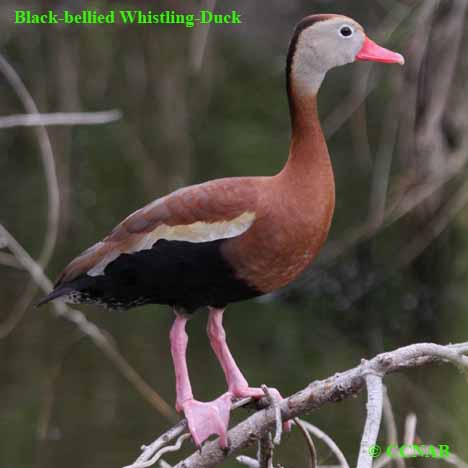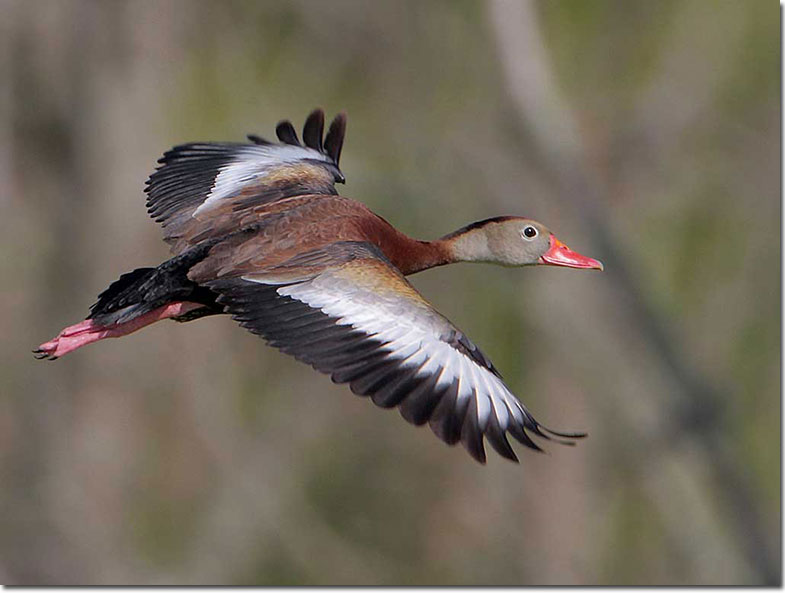Happy Waterfowl Wednesday!
We had some record-breaking warmth today here in New Jersey. The high was 61 degrees, but unfortunately the spring like weather won’t last long. The temperatures will be plummeting tonight and it’s predicted that we will get 4-8 inches of snow tomorrow. I’m not sure what the outcome will be, but I wasn’t ready to let go of the warm weather idea. I was looking through my field guide I found an unusual-looking duck that lives in mainly warm weather regions: the Black-bellied Whistling Duck. So as I’m dealing with a snow storm tomorrow, I’ll just imagine I’m in Florida with the Black-bellied Whistling Ducks haha :-).
Black-bellied Whistling Duck (Dendrocygna autumnalis)
Description:
Black-bellied Whistling Ducks are fairly large, lanky ducks with long necks. Adults have a chestnut brown breast/black, a black belly, white wing patches, and gray heads. Whistling Ducks have a pale, but distinct eye-ring. They also have bright pink bills and legs. Whistling Ducks are an example of monomorphism, where it is difficult to tell apart males and females based on physical appearance. Juveniles are duller in appearance with a pale breast, mottled black belly, and dark bill.
Range:
Year Round: Florida, Southeast Texas, the Gulf Coast of Louisiana, the coasts of Mexico, Southeast Arizona (seasonally), and extensively throughout Central and South America. Summer (breeding): Lousiana, Eastern Texas, Southern Arkansas. Rare in other Southeast and Midwestern states.

Habitat:
Ponds surrounded by trees, freshwater lakes, open fields; a variety of human-made habitats such as school yards, city parks, a golf course. Being able to adapt well to habitats altered by humans have help the Whistling Duck expand their range northward in recent years.

Diet:
Whistling Ducks typically forage at night mainly for seeds, and a variety of grasses. They are dabblers in shallow water for small aquatic animals. They will commonly forage in agricultural fields such as corn, wheat, and millet.
Breeding:
One thing that distinguishes Black-bellied Whistling Ducks from other duck species is the fact they they a monogamous and may mate for life. This behavior is more typical in geese and swans than ducks. Another unique Black-bellied characteristic is the lack of complex courtship behavior that other ducks display. Whistling Ducks will lay their eggs in tree cavities on top of whatever debris is already there. Both parents will take turns incubating the 12-16 eggs for 25-30 days. It’s common for females to lay their eggs in other female’s nests, which is referred to as “egg dumping” (and is an example of brood parasitism). Some of the “dump nests” can have up to 50-60 eggs in them!
Like other duck species, Whistling Duck chicks are precocial, so they will jump out from the nest a day or two after hatching with the ability to feed themselves. The parents will tend to the chicks for about 2 months before they fledge.

Sounds:
As you would imagine from their name, Black-bellied Whistling Ducks let out a wheezy but sharp whistle. The whistle is usually 5-6 syllables: pit pit WEEE do deew! They use this whistle during flight and while swimming and standing. While taking flight they will make a yip and sometimes a chit-chit-chit
Conservation:
Black-bellied Whistling Ducks are highly adaptable and considered a “least concern”. Populations have increased at a rate of around 6% per year from 1966-2014.The increase is partly due to the availability of nest boxes. It’s legal to hunt them, but they are rarely targeted.
Fun Facts:
- Black-bellied Whistling Ducks can be found in flocks of up to 1,000 birds!
- They like to perch in trees, and used to be called the Black-bellied Tree Duck.
- Population estimates are between 1 and 2 million ducks.

